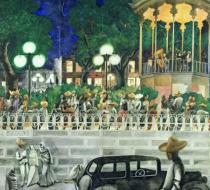How Mexico Formed A United National Identity Through Art Favorite
"Beginning in 1910, the Mexican Revolution spawned a cultural renaissance, inspiring artists to look inward in search of a specifically Mexican artistic language. This visual vocabulary was designed to transcend the realm of the arts and give a national identity to this population undergoing transition. We take a closer look at the artworks produced during this turbulent time in Mexican history, considering the ways in which visual art created a unified Mexican aesthetic.
Born in 1907, renowned Mexican painter and political activist Frida Kahlo would say that she was born the year the Mexican Revolution started. This national rebellion proved such an integral part of the artist’s life and work that she correlated her entrance into the world with the moment in which the Mexican people began to act in force to restore their land to the hands of its citizens.
The revival of a purely Mexican artistic voice in response to revolution is the subject of the 2013 exhibition at the Royal Academy of Arts (RCA) in London. Along with Kahlo’s painfully revealing works of art, this retrospective also brought about ardent political imagery in the form of murals by Diego Rivera, José Clemente Orozco and David Alfaro Siqueiros. As vibrations of communal fervor reached artists and activists across the Atlantic, European figures such as Josef Albers, Edward Burra, and Henri Cartier-Bresson journeyed to Mexico to join in the dynamism. These artists sought, above all, to create a specifically Mexican identity and unity.
This cultural renaissance originated with the widespread political dissent felt by the Mexican people at the turn of the century. The previous century had been one of tumult, defeat, and problematic modernization. War with the United States had led to a tremendous loss of Mexican land, French intervention under Emperor Napoleon III, and the near dictatorship of Porfirio Diaz; and mass industrialization displaced a largely rural population. The autocratic Diaz sat firmly in a seat of power for over a quarter of a century, and in 1910 was finally removed at the hand of Francisco Madero and other guerilla leaders like Pancho Villa and Emiliano Zapata. That these three leaders differed greatly in their beliefs led to utter bedlam, and revealed the ideological inadequacies of the Revolution as a whole."
By
Ellen Von Weigand







